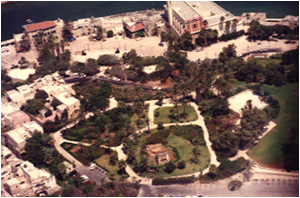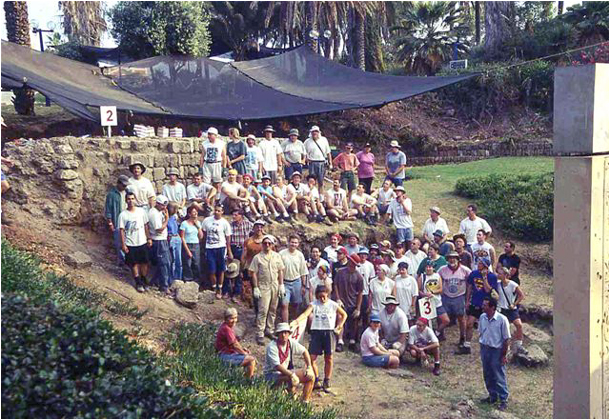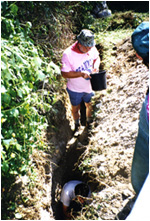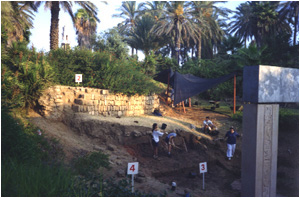

|
TEL YAFO EXPEDITION
Excavations at Ancient Jaffa (Joppa) |
||
|
We are looking for students, scholars, institutions, individuals or groups, donors or patrons, to join us
for a new and exiting project at Ancient Jaffa.
Sponsoring Institution: Institute of Archaeology, Tel Aviv University. Consortium Institutions: Wisconsin Evangelical Lutheran Synod; Villanova University, Philadelphia, Pennsylvania; Macquarie University, Sydney, Australia. Director: Prof. Ze'ev Herzog |
 |
|
|
Location of the Site The mound of ancient Jaffa is located in "Old Jaffa," a picturesque neighborhood in southwestern Tel Aviv. |
||
 |
"Old Jaffa Development Co. Ltd" monitors the archaeological site as part of the local park. An underground Visitor Centre exhibits Jaffa's history and some of its remains from the Hellenistic through Byzantine Periods. A nearby archaeological museum presenting some of the finds from Jaffa and its neighboring sites is located in an old bathhouse of the second half of the 18th Century CE (Hammam). Many art galleries, restaurants and coffee shops are located near the site.
Previous Explorations Jaffa is mentioned in the Old Testament as a border city of the Territory of Dan (Josh 19: 46). Through the "Sea of Joppa", timber from Lebanon was shipped to build the Solomonic temple in Jerusalem (2 Chr. 2: 16) and the prophet Jonah hired a ship in Joppa to escape "away from the |
|
|
presence of the Lord" (Jonah 1: 3).
The site was excavated mainly by the late Jacob Kaplan in the late 50s through early 70s. Among his major discoveries are a Middle Bronze Age earthen glacis, a Late Bronze Age gate and a temple attributed to the Sea Peoples. Occupational remains of the Iron II, Persian and Hellenistic periods were also unearthed. In 1991 a replica of the gate lintels, bearing the titles of Pharaoh Ramses II, was reconstructed by R. Ventura and Z. Herzog and erected in their original location. In 1997 Herzog conducted a short trial season at the site in order to determine the state of its preservation. We exposed additional parts of the gate's entrance floor and the destruction debris above it and cleaned the top of some Iron Age walls to the north of the gate. We also made probes across the mound and found out that large parts of the site are buried under thick layers of modern fill. |
||
|
Tel Yafo (Ancient Jaffa)
Ze'ev Herzog 
INTRODUCTION The mound of Tel Yafo (ancient Jaffa) is located on a high promontory jutting into the Mediterranean Sea and overlooking a natural anchorage. The site was widely excavated by Jacob Kaplan on behalf of the Museum of Antiquities of Tel Aviv-Yafo, between 1955 and 1974, but the full documentation of the results was not published. Most of the excavated areas have been filled with modern debris and partially turned into a community park. Excavations at ancient Jaffa were renewed in 1997 by Z. Herzog, on behalf of the Tel Aviv University Institute of Archaeology, in conjunction with the Old Jaffa Development Company and with the participation of a group of Lutheran institutions (LIBRA) from the United States and with Macquarie University, Sydney. The excavations were concentrated in the area of the Egyptian citadel and part of the gate in Kaplan's excavations. Preliminary soundings by the expedition in 1997 to identify the expansion of ancient remains were followed by full-scale excavations in 1999 aimed at exposing the interior of the Egyptian citadel west of the gate. During the 1999 season, two main areas were excavated: a total of 750 sq m in the southern area and 150 sq m in the vicinity of the gate. The stratigraphic sequence employed by the expedition, in general, followed that established by Kaplan. Middle Bronze Age Gate (Strata VIII-VII) Exploratory excavations in the area of the Late Bronze Age gate revealed earlier stone foundations, apparently of the Middle Bronze Age IIB gate (Stratum VIII), which were later incorporated into the Late Bronze Age gate. The available portions of the gate consist of the wall remains of the southern side of the gate and include a corner of a tower and two pilasters with an inset wall between them (Wall 182). One pilaster, 2.30 m long, was completely exposed, and of the other pilaster, a 1.50-m long segment was uncovered. The pilasters projected about 1.10 m into the gate's passageway. The inset wall between the two pilasters was 2.65 m long. These dimensions are similar to those of the Middle Bronze Age gates discovered at Yavneh Yam and Beth Shemesh. No city wall was found flanking the sides of the gate. Instead, an earthen rampart, made of crushed kurkar (sandstone), was built against the gate. Sections of this rampart were exposed by Kaplan and by the recent excavations in the southern area. The gate may have been reused in the Late Bronze Age I and IIA (Strata VI, V). |
||
 |
Late Bronze Age IIA (Stratum V) Jaffa is mentioned in the El-Amarna letters as an Egyptian administrative centre and important finds from the Amarna period were uncovered by the new expedition (in Area N). The "Lion Temple," was attributed by Kaplan to the Iron Age I (pre-Philistine period). However, when the remains were re-exposed in 1999 it became apparent that the building was partly overlaid by a massive brick wall, made of grey bricks that are identical to the repaired part of the Stratum IVA (Late Bronze IIB) gate. Thus the temple, which was partly destroyed by the brick structure, must date to the Late Bronze Age IIA (Stratum V). Corroboration for this date is provided by the fragment of a scarab of Queen Tiy, wife of Amenhotep III, found in the temple. Near the scarab a skull identified as that of a lion was found, that gave the buildings its title. Incorporated into the grey brick wall of the gate of Stratum IVA (Area J), one of the most important finds made at Jaffa came to light - a huge royal scarab bearing an eight-line inscription in hieroglyphics. The inscription depicts the name and titles of Amenhotep III, king of Egypt in the fourteenth century BCE, |
|
|
the name of his wife Tiy, and the declaration that by the tenth year of his reign the king had successfully hunted one hundred
and two lions. Such royal scarabs were distributed to all officials throughout the empire. Although the inscription was not
found in situ, it illustrates Jaffa's high role within the Egyptian administration. Another royal scarab bearing just the name
of Amenhotep III was found in another (earlier) phase of the gate, but again not in situ.
|
||
|
The Citadel of Late Bronze Age II, Early Phase (Stratum IVB) The 1999 season provided additional sections of the city gate, first uncovered by Kaplan. The initial phase of the gate was constructed in the Late Bronze Age IIB, as evident from the stones inscribed with the name and titles of Ramses II. Although these blocks were found in a secondary use at the later gate, their attribution by Kaplan to Stratum IVB gate seems most plausible. The new excavations (Area J) uncovered the full width the early phase of the southern gate tower (Wall 152), amounting to a width of 5 m (Stratum IVB). The tower was formed of red and yellow bricks (red clay [hamra] and red |
 |
|
|
clay mixed with crushed kurkar respectively). The southwestern section of the tower survived to a height of about 2.50 m above the gate's passageway. This section does not appear in Kaplan's reports. On the northern side of the passageway the wall was narrower and was almost completely demolished in later periods. A narrow drainage channel made of fieldstones ran through the middle of the gate (Area L), another section of the channel was exposed by Kaplan. On the western side of the gate's passageway several stones from the gate's inner threshold were uncovered. Their irregular position indicates that they were moved from their original position before the gate's collapse.
The gate of Stratum IVB was destroyed in an intense conflagration. A destruction layer about 1.50 m thick, which contained burnt bricks and charred wooden beams fallen from the gate superstructure, filled its passageway. The wooden beams and branches were identified by N. Liphschitz as olive wood, acacia and cedar of Lebanon. The flames also destroyed a considerable portion of the brick wall of the southern tower on the side facing the gate passageway. The wall was repaired during the gate's renovation in Stratum IVA. The inscriptions fix a thirteenth-century-BCE date for the Stratum IVB gate. The Citadel of Late Bronze Age II, Late Phase (Stratum IVA) The gate was rebuilt in Stratum IVA over the ruined foundations. The builders repaired the destroyed side of the southern tower with rectangular grey bricks (Wall 162). Several stone slabs engraved with the titles of Ramses II (originating from the early gate) were incorporated into the gate walls, laid with the inscriptions turned back. The new passageway followed the same course as the earlier gate but was about 2 m higher. A section of the floor of the passageway uncovered by the new expedition demonstrates the enormous effort invested in its construction: the collapsed debris of the early gate was covered with stones, above it was a layer of small pebbles. The surface was covered by a watertight, chalky plaster. Since this stratum suffered no destruction and only meager finds were uncovered on the floor of the gate, it is difficult to ascertain its date. Historical considerations, however, indicate a date at the end of the period of Egyptian rule in Canaan, apparently during the reign of Ramses III, in the first half of the twelfth century BCE. A massive brick wall uncovered by Kaplan in the southern area was rediscovered in the recent excavations. The wall, whose maximum width was 3.20 m, is composed of dark-coloured rectangular bricks, similar to those used to repair the later gate, and it was therefore attributed to Stratum IVA. This thick wall, oriented southeast-northwest, may have marked the southern boundary of the citadel or enclosed part of it at the end of the thirteenth and twelfth centuries BCE. Within the fortress (Area I) a section of the mound was cleared from the concrete remains of a nineteenth-century house. Here brick walls of the Late Bronze Age IIB were uncovered beneath a layer of fill from the Iron Age I. A bench discovered in a paved area between the walls may have served for food preparation. Next to it, a plastered niche in one of the walls contained twelve "Egyptian" bowls, most of them intact. Iron Age (Stratum III) Poor architectural remains dating to the Iron Age were recorded in the 1999 season. The period is recognized mainly through pottery sherds found in fill layers (Stratum III). In the gate area an ashlar wall of the Persian period was found resting directly on the brick walls of the Late Bronze Age. The paucity of remains attests to a low level of construction efforts. Several sections of walls and floors on the northern side of the gate are apparently remains of a fort extending along the northern side of the mound, but its plan cannot be reconstructed. Layers of earth fill and rubbish pits revealed on the southern side (Area I) attest that this part of the site was already outside the inhabited zone. The finds here represent remains of the Iron Age I (eleventh and beginning of the tenth centuries BCE) and Iron Age IIB (eighth century BCE). Persian (Stratum II) and Hellenistic (Stratum I) Periods Remains of structures built of ashlar masonry in combination with fieldstones were discovered in all excavated areas. The remains of the Persian period (Stratum II) were found above the earth fill of the Iron Age and included stone foundations and walls typical of Phoenician building technique: segments of ashlar masonry with a fill of fieldstones between them. The walls are identical in their construction and alignment with the extensive building remains uncovered by Kaplan and dismantled during the course of his excavations. Judging from their contents, these structures served as storerooms and workshops and underwent frequent repair and alteration. Jaffa in the Persian period was under Phoenician rule; an abundance of imported Greek objects were uncovered from this period. A stone anchor and a number of coins also date to this phase. According to the pottery and coins discovered in the topmost layers, the buildings continued in use, with alterations, in the Hellenistic period (Stratum I). |
||